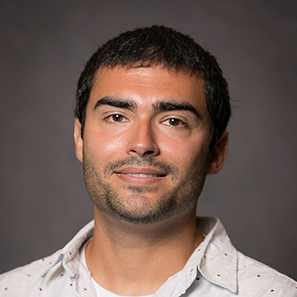
Kenneth Hoadley
Assistant Professsor
- kdhoadley@ua.edu
- 205W Marine Science Hall (Dauphin Island Sea Lab)
- Website
- Not Accepting Students
Education
- Postdoctoral research, GEOMAR: Helmholtz Centre for Ocean Research
- Postdoctoral research, Monterey Bay Aquarium Research Institute
- PhD, Marine Studies, University of Delaware, 2016
Research Interests
- Coral symbioses and climate change
- Algal ecophysiology
- Primary productivity and photosynthesis
- Photo-optical properties
- Gene expression
- Instrument development
Selected Publications
- Susanne Wilken, Charmaine Yung, Maria Hamilton, Kenneth Hoadley, Juliana Nzongo, Charlotte Eckmann, Maria Corrochano Luque, Camille Poirier, Alexandra Z. Worden. 2019: Accounting for cell biology in identifying predatory mixotrophs in aquatic environments. Philosophical Transactions B. doi:10.1098/rtsb.2019.0090.
- Hoadley KD, Lewis A, Wham D, Pettay DT, Grasso C, Smith R, Kemp D, Lajeunesse T, Warner ME. 2019: Specific host–symbiont combinations dictate the response of reef-building corals to thermal stress. Scientific Reports. doi:10.1038/s41598.
- Yuan X, Cai WJ, Meile C, Hopkinson BM, Ding Q, Schoepf V, Warner ME, Hoadley KD, Chen B, Liu S, Huang H, Ye Y, Grottoli AG. 2018. Quantitative interpretation of vertical profiles of calcium and pH in the coral Marine Chemistry, 204, 62-69.
- Grottoli AG, Martins PD, Wilkins MJ, Johnston MD, Warner ME, Cai WJ, Melman TF, Hoadley KD, Pettay DT, Hu X, Levas S, Schoepf V. 2018. Coral physiology and microbiome dynamics under combined warming and ocean acidification. PloS one, 13(1). doi:10.1371/journal.pone.0191156.
- Hoadley KD, Warner ME. 2017. Use of open source hardware and software platforms to quantify spectrally dependent differences in photochemical efficiency and functional absorption cross section within the dinoflagellate Symbiodinium spp. Frontiers in Marine Science, Special Issue: Coral Ecophysiology. doi:10.3389/fmars.2017.00365.
- Schoepf V, Hu X, Holcomb M, Cai WJ, Li Q, Wang Y, Xu H, Warner ME, Melman TF, Hoadley KD, Pettay DT, Matsui Y, Baumann JH andGrottoli AG. 2017. Coral calcification under environmental change: A direct comparison of the alkalinity anomaly and buoyant weight technique. Coral Reefs, 36(1), 13–25.
- Hoadley KD, PettayDT, GrottoliAG, CaiW, MelmanTF, Levas S, Schoepf V, HuX, LiQ, XuH, WangY, MatsuiY, BaumannJ,Warner 2016. High-temperature acclimation strategies within the thermally tolerant endosymbiont Symbiodinium trenchii and its coral host, Turbinaria reniformis, differ with changing pCO2 and nutrients. Marine Biology, 163(6), 1–13.
- Hawkins TD, Hagemeyer J, Hoadley KD, Marsh AG, Warner ME. 2016. Partitioning of respiratory demand in a model animal-algal symbiosis is determined by the interaction of symbiont species and biomass. Frontiers in Physiology, 128(7). doi:3389/fphys.2016.00128
- Hoadley KD, Vize P, Pyott SJ. 2016. Current understanding of the molecular mechanisms behind cnidarian behavioral and physiological responses to natural light cycles. In: Goffredo S, Dubinsky Z. (eds) The Cnidaria, Past, Present and Future. Springer, pp511–520.
- Cai WJ, Ma Y, HopkinsonB, GrottoliAG, Warner ME, DingQ, Hu X, YuanX, XuH, HanC, SchoepfV, MelmanT, HoadleyKD, PettayDT, MatsuiY, BaumannJH, LevasS, YingY, Wang 2016. Microelectrode characterization of coral interior pH and carbonate chemistry. Nature Communications, (7). doi:10.1038/ncomms11144.
- Marsh AG, Hoadley KD, Warner ME. 2016. Distribution of CpG motifs in upstream gene domains in a reef coral and sea anemone: Implications for epigenetics in cnidarians. PLoS One 11(3). doi:10.1371/journal.pone.0150840.
- Russell B, Dierssen H, Lajeunesse T, Hoadley KD, Warner ME, Kemp DW, Bateman T. 2016. Spectral reflectance of palauan reef-building coral with different symbionts in response to elevated temperature. Remote Sensing, 8(3). doi:10.3390/rs8030164.
- HoadleyKD, PettayDT, DodgeD, Warner 2016. Contrasting physiological plasticity in response to environmental stress within different cnidarians and their respective symbionts. Coral Reefs, 35(2), 529–542.
- Hoadley KD, PettayDT, GrottoliAG, CaiW, MelmanTF, SchoepfV, HuX, LiQ, XuH, WangY, MatsuiY, BaumannJ,Warner 2015. Physiological response to elevated temperature and pCO2 varies across four Pacific coral species: Understanding the unique host+symbiont response. Scientific Reports, doi:10.1038/srep18371.
- HoadleyKD, RollisonD, PettayDT, Warner 2015. Differential carbon utilization and asexual reproduction under experimental ocean acidification in the model anemone, Exaiptasia pallida, hosting different symbionts. Limnology and Oceanography, doi:10.1002/lno.10160.
- Leal MC, Hoadley KD, Pettay DT, Grajales A, Calado R, Warner ME. 2015. Symbiont type influences trophic plasticity of a model cnidarian-algal symbiosis. Journal of Experimental Biology, 218(6), 858-863.
- Tilney C, Hoadley KD, Warner ME. 2015. Comparing the diel vertical migration of Karlodinium veneficum (dinophyceae) and Chattonella subsalsa (Raphidophyceae): PSII photochemistry, circadian control, and carbon assimilation. Journal of Photochemistry and Photobiology B: Biology, 143, 107–119
- Levas S, GrottoliAG, WarnerME, CaiW, BauerJ, SchoepfV, BaumannJH, MatsuiY, GearingC, MelmanTF, HoadleyKD, PettayDT, HuX, LiQ, XuH, Wang Y. Organic Carbon Fluxes Mediated by Corals at Elevated pCO2 and Temperature. Marine Ecology Progress Series, 519:153-164.
- Schoepf V, Grottoli AG, Warner ME, Cai W-J, Melman TF, Hoadley KD, Pettay DT, Hu X, Li Q, Xu H, Wang Y, Matsui Y, Baumann JH. 2013. Coral energy reserves and calcification in a high-CO2 world at two temperatures. PLoS One, 8(10), doi:1371/journal.pone.0075049.
- Hoadley KD, Szmant A, Pyott S. 2011. Circadian clock gene expression in the coral Favia fragum over diel and lunar reproductive cycles. PLoS One, 6(5), doi: 1371/journal.pone.0019755.